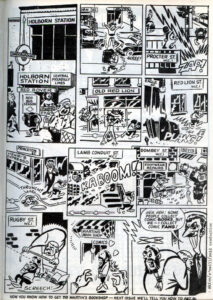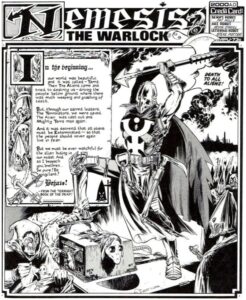Kevin O’Neill, 1953-2022
by Tony Keen 23-Nov-22
Another comics great has left us. Tony Keen writes an appreciation of an artist whose work he has admired and loved for forty years.
 2022 has been a bad year for the loss of comics greats (Alan Grant, Neal Adams, Garry Leach, and sadly more), and now we must add Kevin O’Neill to the list. O’Neill’s art was unique, like nothing you had ever seen before or since. Like a lot of his contemporaries (Mike McMahon, Ian Gibson), he embraced exaggeration and caricature in his art, though he was capable of drawing women as beautiful as any to be found in a US romance comic, as shown by his depictions of Purity Brown in Nemesis the Warlock or Mina Murray in League of Extraordinary Gentlemen. What set O’Neill apart from his contemporaries is that no-one else shared O’Neill’s sense of, and delight in, the grotesque.
2022 has been a bad year for the loss of comics greats (Alan Grant, Neal Adams, Garry Leach, and sadly more), and now we must add Kevin O’Neill to the list. O’Neill’s art was unique, like nothing you had ever seen before or since. Like a lot of his contemporaries (Mike McMahon, Ian Gibson), he embraced exaggeration and caricature in his art, though he was capable of drawing women as beautiful as any to be found in a US romance comic, as shown by his depictions of Purity Brown in Nemesis the Warlock or Mina Murray in League of Extraordinary Gentlemen. What set O’Neill apart from his contemporaries is that no-one else shared O’Neill’s sense of, and delight in, the grotesque.

One of O’Neill’s earliest published works was this 1973 advert for Martin’s Bookshop, published in Fantasy Advertiser International, ancestor of this very website.
O’Neill started working for IPC in the 1970s, and got himself assigned to 2000 A.D. While working there and generally doing little bits of art direction, he did something for which he is not properly credited – he sneaked creator credits into the pages of the comics, something that had not been done before in British comics. This undoubtedly increased the profile of British comics creators, and paved the way for the creator-owned comic Warrior, and the subsequent move in the 1980s of British comics talent to the US market.
O’Neill progressed to more regular strip work for 2000 A.D. in his own right, making a name for himself on Ro-Busters and The ABC Warriors, comics that allowed him to indulge his love of drawing strange robots and machinery. Then, in 1980, after a couple of comedic strips done in a particularly cartoony style, came Nemesis the Warlock, written by Pat Mills (as had been Ro-Busters and The ABC Warriors).
 This was a superb strip that remains one of the best things ever to have been published in 2000 A.D. O’Neill’s intricately detailed grotesqueries were perfect for the strip’s blend of science fiction and medievalism. He was also perfect for a series that was surprisingly uncompromising in its depiction of horror and violence, given that this was supposedly a comic for teenage boys. It was also often the funniest thing to run in 2000 A.D. O’Neill filled the pages with strange aliens and terrifying human armour, drawing on a seemingly bottomless well of imagination.
This was a superb strip that remains one of the best things ever to have been published in 2000 A.D. O’Neill’s intricately detailed grotesqueries were perfect for the strip’s blend of science fiction and medievalism. He was also perfect for a series that was surprisingly uncompromising in its depiction of horror and violence, given that this was supposedly a comic for teenage boys. It was also often the funniest thing to run in 2000 A.D. O’Neill filled the pages with strange aliens and terrifying human armour, drawing on a seemingly bottomless well of imagination.
Unfortunately, the level of detail O’Neill was bringing took a long time. IPC’s demand for new Nemesis material meant that Book Two, largely an exercise in marking time, was drawn by Jesus Redondo, and the prospect of more lucrative work from the US meant that O’Neill left Nemesis after drawing the first couple of strips of Book Four. (Confusingly, Books Three and Four of Nemesis were originally collected as Books Two and Three, due to Titan’s decision to ignore the original Book Two.) Though Bryan Talbot did great work on later books, Nemesis was never quite the same, even when O’Neill made periodic returns to the strip.
O’Neill’s early US work was for DC, a lot of it back-up strips in Omega Men, including a brilliant short story, ‘Brief Lives’, written by Alan Moore. But it was another piece created with Moore, ‘Tygers’, done for a Green Lantern Corps Annual in 1986, that is the most memorable of his DC work. A tale of Abin Sur, Hal Jordan’s predecessor, it features O’Neill’s work at his most baroque and grotesque. The Comics Code Authority objected, and when asked which bits in particular they objected to, said it was O’Neill’s entire style. To their credit, DC ran the story anyway, without the CCA stamp. (Both stories can be found in the collection DC Universe by Alan Moore, where they are highlights).
In 1987, Mills and O’Neill created Marshall Law, a savage satirical attack on superhero comics, in which all superheroes are presented as perverts and psychopaths; the titular character, who owed a lot to Judge Dredd, is responsible for policing them. The relentless diatribes of the strip grow tedious after a while, but O’Neill’s art was always memorable. About the same time, he and Mills created Metalzoic, published by DC as a graphic novel, and then serialised in 2000 A.D., which allowed O’Neill to return to drawing the strange robots that had been the meat of Ro-Busters and The ABC Warriors.
 The last twenty years of O’Neill’s life were mostly taken up with The League of Extraordinary Gentlemen, another collaboration with Moore. This was the work of a more mature O’Neill; the taste for the grotesque and enjoyment of caricature are still there, if perhaps no longer with O’Neill’s imagination as fervent as in the 1970s and 1980s, but he was able to convey far more emotion in his depictions of the human face. The second volume, a retelling of H.G. Wells’ War of the Worlds, is some of the best comics you could ever want to read.
The last twenty years of O’Neill’s life were mostly taken up with The League of Extraordinary Gentlemen, another collaboration with Moore. This was the work of a more mature O’Neill; the taste for the grotesque and enjoyment of caricature are still there, if perhaps no longer with O’Neill’s imagination as fervent as in the 1970s and 1980s, but he was able to convey far more emotion in his depictions of the human face. The second volume, a retelling of H.G. Wells’ War of the Worlds, is some of the best comics you could ever want to read.
We’ll not see O’Neill’s like again.
(Downthetubes.net has an excellent tribute to O’Neill here.)
Tags: Kevin O'Neill